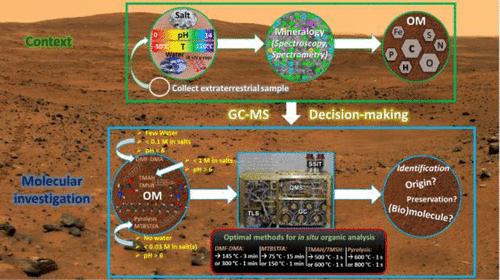揭示火星和海洋世界生物特征的新分析方法
IF 6.7
1区 化学
Q1 CHEMISTRY, ANALYTICAL
引用次数: 0
摘要
地球上的模拟环境及其微生物群落是为探索地外行星环境做准备的关键要素,这些环境可能维持,甚至可能仍然维持生命出现所必需的(生物)化学。陆地模拟环境的特征揭示了以下信息的分布:(1)我们所知道的生命产生的生物分子;(2)可能保存并与古代生命相关的生物分子(如脂类)。我们开发并验证了一种新的非靶向检测生物分子的方法,该方法可以应用于实验室和基于空间的研究,以提取和检测生物分子和/或生物特征,使用气相色谱-质谱联用(GC-MS)。该方法包括使用化学试剂进行一锅反应,以增强有机物的提取和挥发。该研究的新颖之处在于选择反应温度和反应时间,以提取更广泛的有机分子,并得出以下非标准样品的最佳样品制备条件:(i) DMF-DMA在300°C下,1-3分钟,(ii) MTBSTFA在150°C下,1-15分钟,或(iii) TMAH在600°C下,1-30秒。这种方法首先通过对两种极端微生物(古巴蓝细菌和嗜盐古细菌)纯培养物的生物分子的研究得到验证,以在模拟环境(干燥的美国Pilot Valley沙漠和冰岛Gunnuhver温泉)中检测它们,这些环境分别被探索为火星和可能的海洋世界表面的类似物。我们的研究结果表明,与传统方法的多步骤提取和净化相比,这种非靶向方法抑制了有机物和污染物的损失,有利于目前好奇号火星探测器的探索。该方法可以在现场的便携式GC-MS中实施,也可以在航天仪器中使用,以检测各种生物分子(例如氨基酸、羧酸/脂肪酸、醇/糖、核酸等)和地质基质中捕获的含C、O、N、s化合物的万亿分之一(ppt)到ppt。本文章由计算机程序翻译,如有差异,请以英文原文为准。

New Analytical Methodology to Reveal Biosignatures on Mars and Ocean Worlds
Terrestrial analog environments and their microbial communities are key elements to prepare for the exploration of extraterrestrial planetary environments that potentially sustained, or even may still sustain, the (bio)chemistry necessary for life to emerge. Characterization of terrestrial analogue environments reveals information on the distribution of (i) biomolecules produced by life as we know it and (ii) biomolecules potentially preserved and associated with ancient life (e.g., lipids). We developed and validated a new untargeted method to detect biomolecules that can be applied to both laboratory and in situ-space-based research to extract and detect biomolecules and/or biosignatures using gas chromatography coupled to mass spectrometry (GC–MS). The method consists of a one-pot reaction using a chemical reagent to enhance organic matter extraction and volatilization. The novelty of the study was based on the selection of temperature and time of reactivity to extract the wider range of organic molecules and led to the following optimal sample preparation conditions for nonstandard samples: (i) DMF-DMA at 300 °C for 1–3 min, (ii) MTBSTFA at 150 °C for 1–15 min, or (iii) TMAH at 600 °C for 1–30 s. This approach was first validated through investigation of biomolecules from two pure cultures of extremophiles (Chroococcidiopsis cubana cyanobacteria and Halobacterium salinarum halophilic archaea) to detect them in analog environments (the dry American Pilot Valley desert and the Icelandic Gunnuhver hot spring) that have been explored as analogs of Mars and likely ocean world surfaces, respectively. Our findings showed that this untargeted method inhibits the loss of organic matter and contamination compared to multistep extraction and purification in classical methods and benefit explorations by the current Curiosity rover at Mars. The method can be implemented in portable GC–MS in the field or used by spaceflight instrumentation to detect parts per trillion (ppt) to ppt of wide diversity of (bio)molecules (e.g., amino acids, carboxylic/fatty acids, alcohols/sugars, nucleic acids, etc.) and C,O,N,S-bearing compounds trapped in a geological matrix.
求助全文
通过发布文献求助,成功后即可免费获取论文全文。
去求助
来源期刊

Analytical Chemistry
化学-分析化学
CiteScore
12.10
自引率
12.20%
发文量
1949
审稿时长
1.4 months
期刊介绍:
Analytical Chemistry, a peer-reviewed research journal, focuses on disseminating new and original knowledge across all branches of analytical chemistry. Fundamental articles may explore general principles of chemical measurement science and need not directly address existing or potential analytical methodology. They can be entirely theoretical or report experimental results. Contributions may cover various phases of analytical operations, including sampling, bioanalysis, electrochemistry, mass spectrometry, microscale and nanoscale systems, environmental analysis, separations, spectroscopy, chemical reactions and selectivity, instrumentation, imaging, surface analysis, and data processing. Papers discussing known analytical methods should present a significant, original application of the method, a notable improvement, or results on an important analyte.
 求助内容:
求助内容: 应助结果提醒方式:
应助结果提醒方式:


